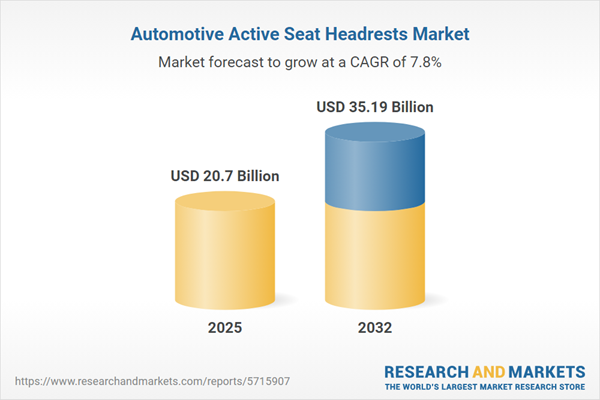Speak directly to the analyst to clarify any post sales queries you may have.
The automotive active seat headrests market is evolving rapidly as safety and comfort become integral to both customer preferences and regulatory frameworks. This report provides senior leaders with an actionable overview of the sector’s growth drivers, competitive landscape, and emerging technology trends.
Market Snapshot: Automotive Active Seat Headrests Market Growth
The Automotive Active Seat Headrests Market grew from USD 19.27 billion in 2024 to USD 20.70 billion in 2025. It is expected to continue growing at a CAGR of 7.81%, reaching USD 35.19 billion by 2032. Senior executives in the automotive supply chain should recognize the sector’s robust pace, driven by regulatory shifts, innovation in occupant protection, and corresponding surges in demand for both OEM and aftermarket solutions. The industry is experiencing strong adoption as intelligent actuation, new materials, and proactive safety features redefine what automotive headrests can deliver.
Scope & Segmentation
Comprehensive coverage ensures strategic clarity across product, technology, end-user, and regional landscapes:
- Product Types: Active car headrests, reactive headrests
- Adjustment Methods: Automatic adjustment, manual adjustment
- Materials: Fabric headrests, leather headrests
- Vehicle Types: Commercial vehicles, heavy-commercial vehicles, light-commercial vehicles, passenger cars, hatchbacks, sedans, SUVs
- End-User Channels: Aftermarkets, OEMs
- Distribution Channels: Offline stores, online stores
- Regions: Americas (United States, Canada, Mexico, Brazil, Argentina, Chile, Colombia, Peru), Europe, Middle East & Africa (United Kingdom, Germany, France, Russia, Italy, Spain, Netherlands, Sweden, Poland, Switzerland, United Arab Emirates, Saudi Arabia, Qatar, Turkey, Israel, South Africa, Nigeria, Egypt, Kenya), Asia-Pacific (China, India, Japan, Australia, South Korea, Indonesia, Thailand, Malaysia, Singapore, Taiwan)
- Technologies: Intelligent actuation systems, sensor integration, haptic feedback, lightweight composites, impact-absorbing foams, digital manufacturing
Key Takeaways: Strategic Insights for Senior Decision-Makers
- Advanced headrest systems are a focal point of OEM differentiation, integrating sensors and electronics to provide dynamic support and reduce injury risk in real time.
- Material innovation aligns with automaker initiatives for reduced vehicle mass while enhancing energy absorption, supporting sustainability and cost-optimization goals.
- Demand for personalized seating solutions is spurring rapid growth in automatic adjustment systems, signaling a shift toward user-centric vehicle interior architectures.
- The active seat headrest sector is adapting to increasingly complex safety regulations, resulting in elevated R&D investment and greater collaboration between suppliers and regulatory bodies.
- Regional production hubs and local partnerships are essential for overcoming tariff-related challenges and supply chain complexity, ensuring scalable and flexible operations.
- Aftermarket uptake is accelerating, fueled by retrofitting trends in emerging markets and digital distribution channels, which facilitate direct consumer access and custom configuration.
Tariff Impact: Navigating U.S. Tariff Adjustments
U.S. tariff adjustments enacted in 2025 have altered supply chain and procurement strategies. Manufacturers are relocating production lines to duty-exempt regions, deepening domestic supplier collaboration, and adopting lightweight, tariff-resistant materials. A notable trend toward regionalization and vertical integration is evident, as firms aim to insulate operations from cost volatility and trade policy shifts. These strategies collectively reinforce resilience and agility across the sector’s value chain.
Methodology & Data Sources
This report follows a rigorous mixed-methods approach, combining executive interviews, structured industry surveys, and secondary research. Value-chain mapping, scenario planning, and advanced statistical techniques underpin our analysis, ensuring results are robust and actionable for leadership audiences.
Why This Report Matters
- Enables senior leaders to anticipate safety, regulatory, and technology shifts driving market evolution.
- Empowers procurement and product teams to refine sourcing, design, and go-to-market strategies in response to global and regional market forces.
- Delivers data-driven insights for board-level decision-making around future partnerships, R&D allocation, and operational risk management.
Conclusion
The automotive active seat headrests market is positioned for continued transformation, shaped by advanced safety technologies, regulatory adaptation, and regional supply chain strategies. Companies embracing these dynamics will strengthen competitive resilience and capture new growth opportunities.
Additional Product Information:
- Purchase of this report includes 1 year online access with quarterly updates.
- This report can be updated on request. Please contact our Customer Experience team using the Ask a Question widget on our website.
Table of Contents
3. Executive Summary
4. Market Overview
7. Cumulative Impact of Artificial Intelligence 2025
Companies Mentioned
The companies profiled in this Automotive Active Seat Headrests market report include:- Adient PLC
- Deprag Schulz GmbH
- Grammer AG
- Guelph Manufacturing Group
- Hyundai Transys Slovakia s. r. o.
- Innotec, Corp.
- JR Manufacturing Inc.
- Knauf Industries Polska Sp. z.o.o.
- Lear Corporation
- Magna International Inc.
- NHK Spring Co., Ltd.
- Ningbo Chunji Technology Co., Ltd.
- Ningbo Jifeng Auto Parts Co., Ltd.
- Nippon Steel Trading Corporation
- Reell Precision Manufacturing, Inc.
- Schmale Maschinenbau GmbH
- Shanghai Daimay Automotive Interior Co. Ltd.
- Sumitomo Riko Company Limited
- Toyota Boshoku Corporation
- TS Tech Co. Ltd.
- Windsor Machine Group
- Yanfeng International Automotive Technology Co. Ltd.
Table Information
| Report Attribute | Details |
|---|---|
| No. of Pages | 183 |
| Published | November 2025 |
| Forecast Period | 2025 - 2032 |
| Estimated Market Value ( USD | $ 20.7 Billion |
| Forecasted Market Value ( USD | $ 35.19 Billion |
| Compound Annual Growth Rate | 7.8% |
| Regions Covered | Global |
| No. of Companies Mentioned | 23 |









